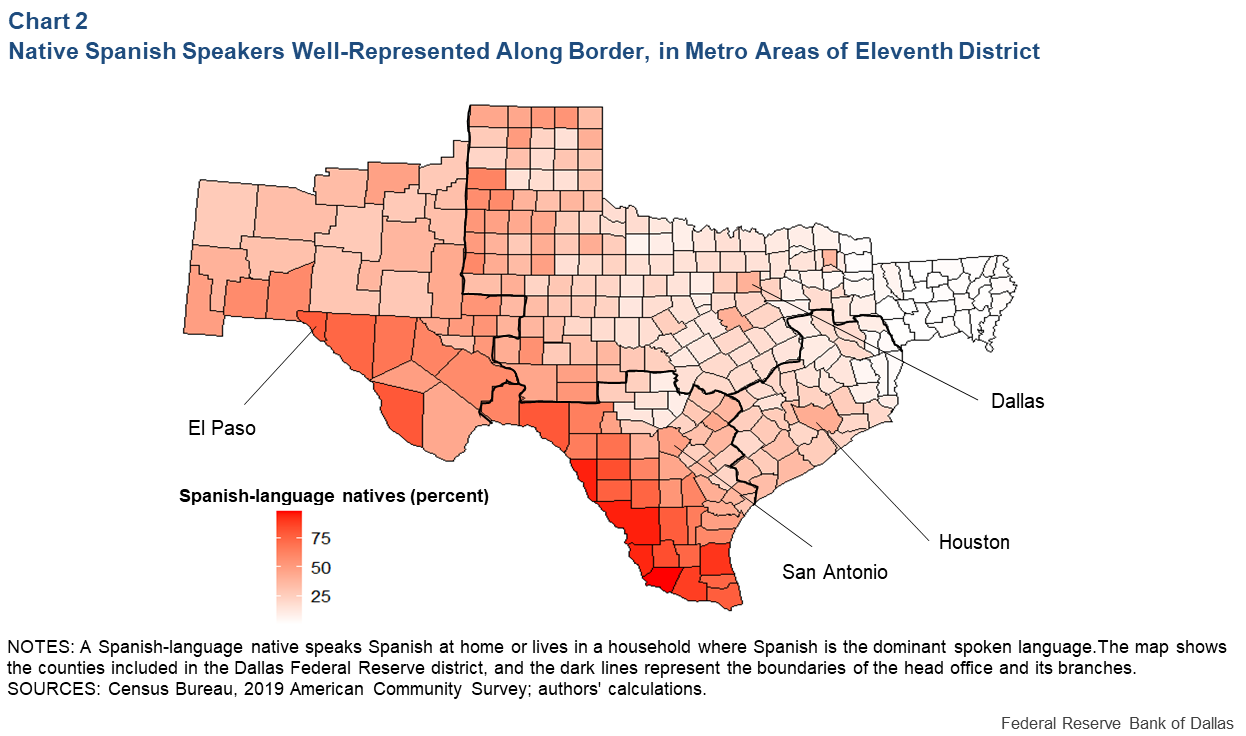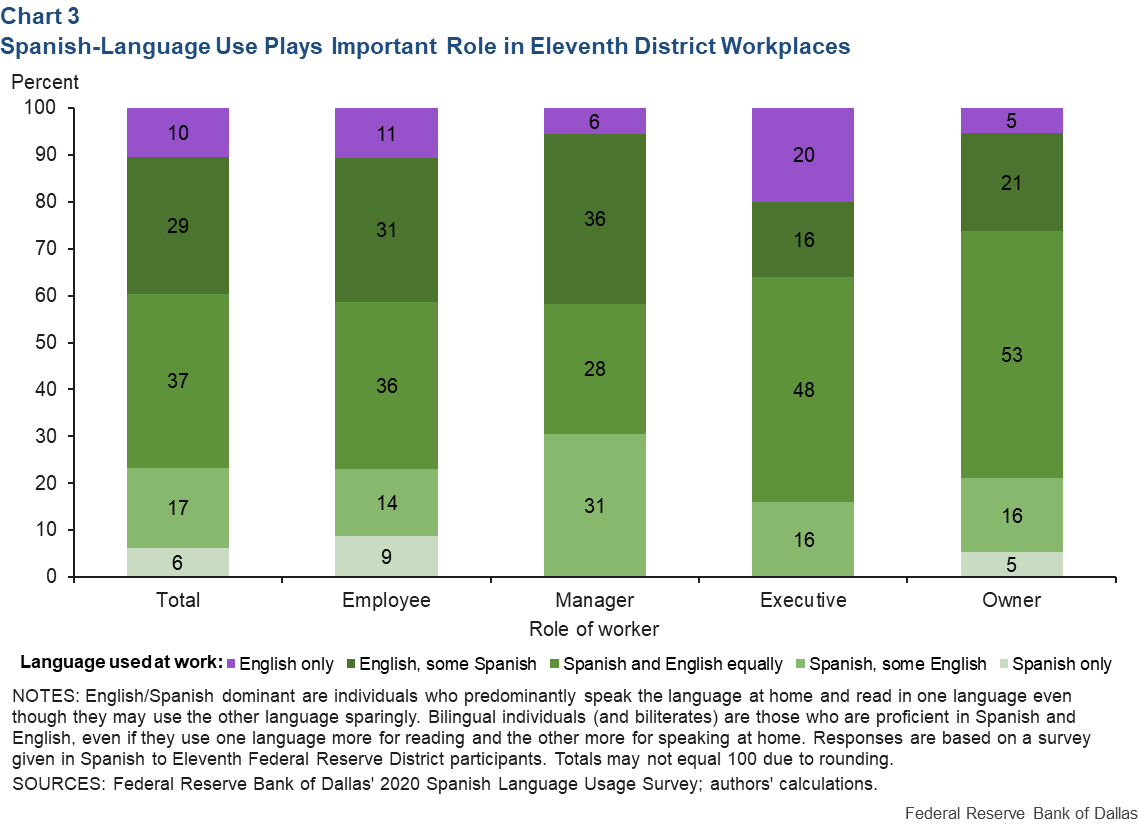
Spanish-Speaking Growth in Texas Reinforces Need to Close Education Gaps
The Eleventh Federal Reserve District has the second-largest native Spanish-language population in the Federal Reserve System—at nearly 11 million people. That population will grow further as the number of Hispanics is expected to exceed 20 million in Texas alone by 2050.
The burgeoning estimates suggest Spanish-language usage will likely expand, though realizing the economic benefits of bilingualism remains challenging, in part because of education deficiencies.
Promoting growth and economic opportunities
A bilingual population provides businesses a competitive advantage to reap the benefits of trade and investment opportunities from a community of more than 580 million Spanish speakers worldwide. Additionally, in the U.S., immigration from Spanish-speaking countries helps offset an ongoing working-age population decline.
The disposable income of Spanish-language natives in the U.S. equals the size of Mexico’s economy. And within the Eleventh District—Texas, southern New Mexico and northern Louisiana—the large bilingual labor force has helped attract new firms, a cornerstone of the region’s growth.
More broadly, the ability to speak two languages has been linked to benefits that include enhanced cognitive ability, empathy and interpersonal skills and improved learning outcomes. Bilingual education from an early age can help children develop broader language skills and, ultimately, level the playing field for low-income families, some of which are recent arrivals in the country.
Expansive reach of Spanish-language natives
The U.S. native Spanish-language population is densely concentrated in the Southwest and along the coasts. This population is largest in the San Francisco Federal Reserve district, with more than 18 million people, followed by the Dallas district, with almost 11 million, according to the Census Bureau’s 2019 American Community Survey (ACS) (Chart 1).

The Eleventh District stands out because Spanish-language natives represent the largest share of all non-native English speakers (81 percent). Within the district, they tend to locate along the border and in the major metropolitan areas (Chart 2).

Spanish-language natives are the majority in the areas of two Dallas Fed branches, San Antonio (50 percent of the population) and El Paso (59 percent). In 47 counties within the district, Spanish-language natives are at least 50 percent of the population—including Webb County (Laredo) at close to 95 percent, Hidalgo County (McAllen) at almost 88 percent and El Paso County at 78 percent.
In absolute numbers, Harris County (Houston) is the most populous with 2 million Spanish-language natives (42 percent of the county population), followed by Dallas County with 1.1 million (40 percent) and Bexar County (San Antonio) with 1 million (48 percent).
Wide-ranging language use
To supplement the ACS data, the Dallas Fed conducted a districtwide survey on the use of Spanish. The Spanish-only online questionnaire was available Sept. 21–29, 2020, reaching 400 participants. Self-selection among the respondents means the survey captured more than just Spanish-language natives; respondents included second-language learners and bilingual individuals whose mother tongue is not Spanish.
Among the main results, Spanish speakers use Spanish extensively in the workplace, indicating direct economic benefits attached to this language skill. Spanish is most used by managers and business owners, with approximately 95 percent of those participants reporting that they use it to some extent at work (Chart 3).

Spanish tends to be more widely used in agriculture, mining and some manufacturing industries as well as in business-to-consumer services such as sales, call centers and marketing/advertising.
Bilingual individuals are those proficient in Spanish and English given their self-reported ability to speak and read in both languages, while dominant speakers are those who lean more heavily on one of the languages for both speaking and reading. At work, 92 percent of bilingual respondents use Spanish, rising to 98 percent among the Spanish dominant. Two-thirds of English-dominant individuals use Spanish at work to some extent, the survey found.
Intergenerational transmission remains resilient
Foreign-language use tends to phase out after three generations, so the resilience of Spanish as a minority language in the U.S. depends on continued intergenerational transmission.
Children whose parents are already English dominant are most at risk of dropping Spanish, following this three-generation pattern (Chart 4).

In contrast, the rate at which Spanish is passed to the next generation is very high for bilingual individuals and Spanish-dominant speakers. In fact, the trend for the overall population is toward bilingualism rather than abandoning Spanish.
Fifty-six percent of surveyed bilingual individuals with children raised their offspring to speak English and Spanish. Children whose parents speak predominantly Spanish are likely to retain Spanish, with 34 percent becoming bilingual. The survey findings show that, apart from its value in the workplace, support within the household and access to Spanish-language media and entertainment increase the propensity to retain the language.
Dealing with bilingual-education shortfalls
Developing school curricula that help students speak, read and write in two languages across different subjects is vital to achieving proficiency in Spanish and English. While many schools teach Spanish, the nation has a shortage of qualified teachers. Even where available, Spanish classes often cannot progress at the pace expected when learning in English.
To get a sense of the acute need for Spanish-language instructors, consider that the K-12 Spanish-language native population in the U.S. was about 1.6 times larger than the number of students enrolled in classes for Spanish as a second language in 2015. In parts of the Eleventh District, approximately two-thirds of Spanish-language natives of K-12 age are unlikely to have been directly exposed to Spanish in the classroom.
Capitalizing on the benefits of bilingualism requires acknowledging the role that dual speakers play in the district’s cultural landscape and economy as well as finding new ways to reach second-language and bilingual-education students. Doing so likely necessitates that more resources be devoted to adequately support the Spanish–English bilingual competencies of tomorrow’s workforce.
This article is available in Spanish.
About the Authors
The views expressed are those of the authors and should not be attributed to the Federal Reserve Bank of Dallas or the Federal Reserve System.







